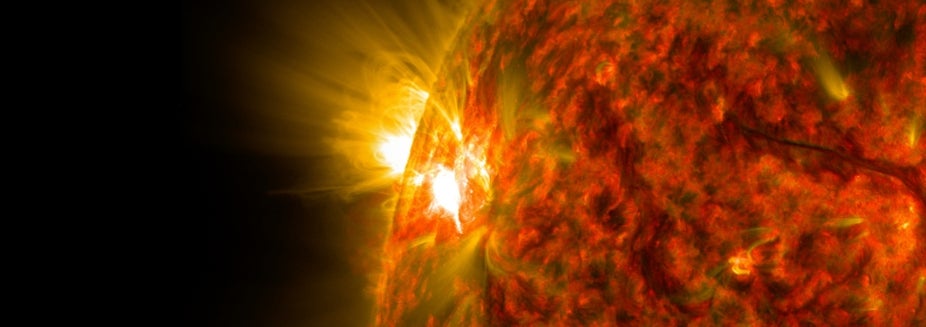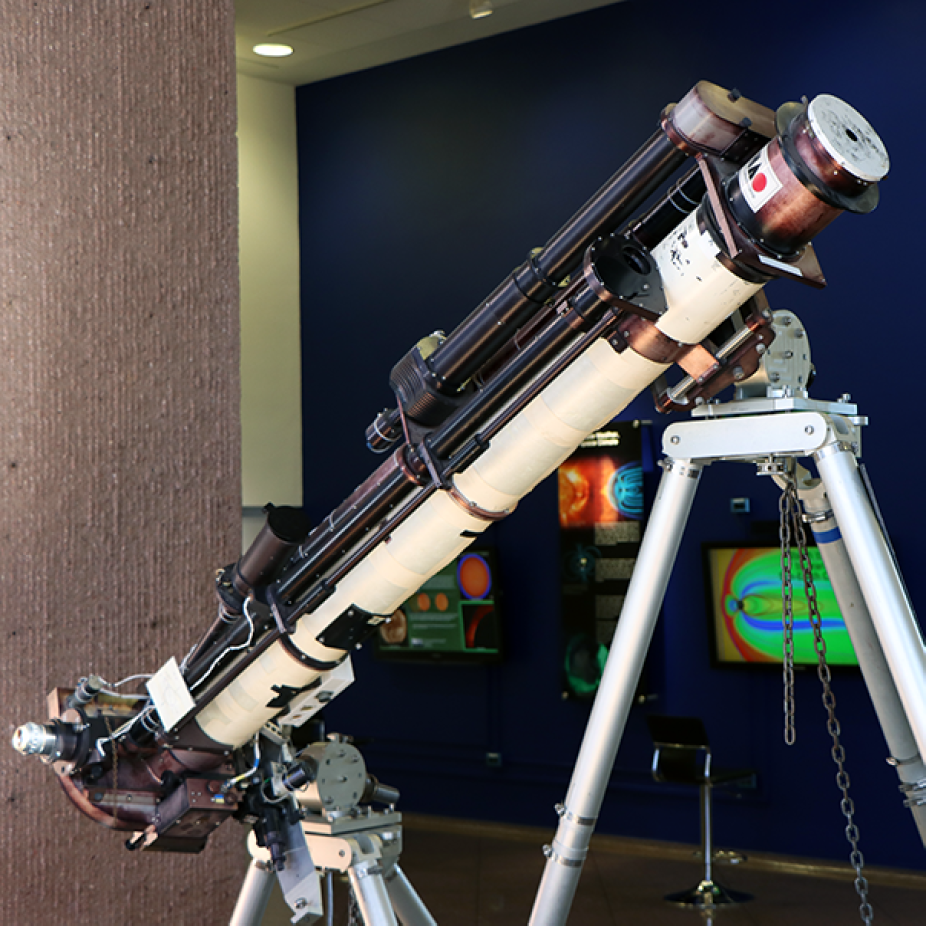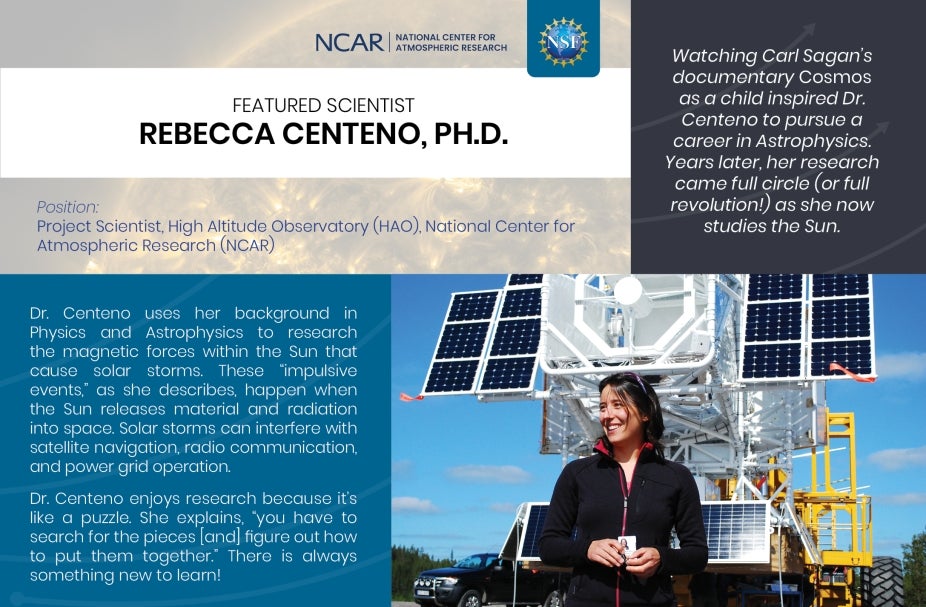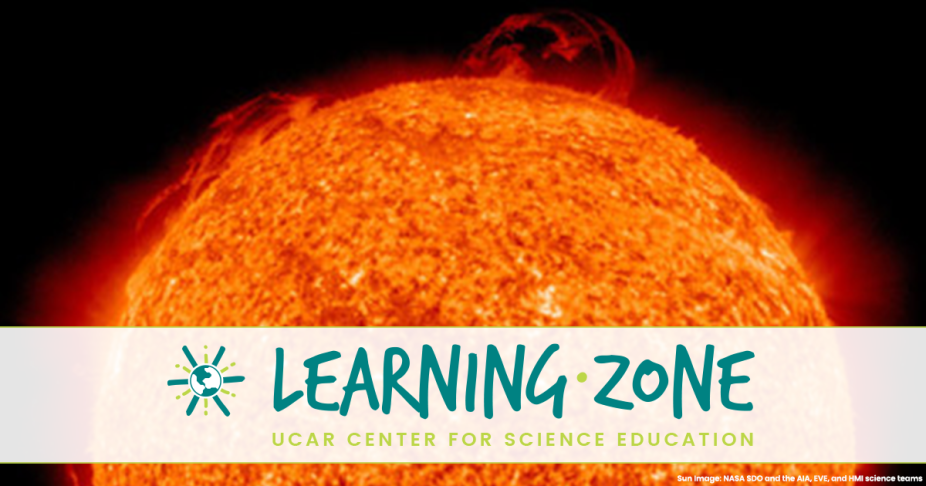Space Weather & Space Climate

NASA/SDO

Our Sun constantly emits solar radiation and energetic particles, which cause space weather and space climate. The effects of this can be as beautiful as aurora and as damaging as power outages. Explore the resources below to learn more!
Topics
What is an eclipse?
A solar eclipse happens when the Moon passes between the Sun and Earth, blocking the Sun's light. This can create a shadow on Earth, where the sky darkens and the Sun looks like a dark disk or a ring of light. Solar eclipses can be total, partial, or annular, depending on how much of the Sun's light is blocked. Want to know more? Check out the NSF NCAR Explorer Series Lecture with Dr. Paul Bryan's, "When you need darkness to see the light: Total solar eclipses."
Native American cultures have diverse views on eclipses. For example, the Navajo people believe that an eclipse is a sacred time when the sun and moon are interacting. They treat eclipses with reverence and prayer, and they often stay indoors during an eclipse. The Shoshone-Bannock tribes in Idaho believed that bad things would happen to bad people during eclipses. The Pawnee people of Oklahoma saw eclipses as a time of sorrow, as they believed that an eclipse meant that a great leader was going to die. Overall, eclipses are seen by Native Americans as a time of great spiritual significance. They are an opportunity to connect with the natural world and the spirit realm.
Check out these resources on Navajo knowledge of the Cosmos and how other Native American beliefs or protocols concerning the eclipse.
Would you like to view the eclipse through one of our specially designed eclipse glasses? Request Eclipse Glasses here! Please submit your request by March 28th, 2024.
These glasses are free of charge, and are offered through the U.S National Science Foundation National Center for Atmospheric Research's Education, Engagement and Early-Career Development (EdEC) Engagement section. Requests will be fulfilled, when possible, on a first-come-first-served basis. We’re offering shipment via prepaid FedEx labels or local pickup at specific locations/times. You will not be able to pick up glasses at the Mesa Laboratory outside of the delivery windows we establish. Further details will come via email.
Developed as a took for the Blind and Low Vision (BLV) community to experience the eclipse, the LightSound device uses sonification to convert light intensity to sound. Learn more or request your own device on The LightSound Project webpage.
April 8th, 2024 Total Solar Eclipse
Folks in Mexico, across much of the continental United States, and eastern Canada will have the opportunity to experience a total solar eclipse. This chance is a rare opportunity, and one that will not come back through the continental US until 2045! While a partial eclipse will be visible across much of North America, to see the total eclipse you must be somewhere along the path of totality. If you live within the path of totality, congrats! You can view the eclipse from right where you are. If you are within the path of totality or are planning to travel to see the eclipse, we’ve prepared a list of things to consider to ensure the best experience possible. Not sure where to go? Check out the In the Path webpage for events and other opportunities along the path of totality.
You'll have the best chance of seeing the eclipse at a location that is less likely to be cloudy or stormy. Weather Underground keeps a historical record of weather conditions. Check the location you have in mind to see if it’s typically cloudy on this date. For example, Uvalde, TX shows it was cloudy on April 8, 2023, but fair the previous years. Of course, weather will be weather, so check forecasts leading up to the day for a more accurate prediction.
Coloradans will tell you, the 2017 eclipse was an amazing experience, but the drive back was not. This is because most travelers left around the same time and had one major highway to handle all of the traffic. If you are traveling, consider carpooling, or taking a train or public transportation when possible. Consider multiple routes home, or leave later to avoid the initial busy road conditions. If you’re flying, buy your tickets early, and give yourself extra time to get through the airport, as there could be unusually high airport traffic leading up to, and after the eclipse.
Except during the couple of minutes of totality, it is never safe to look directly at the Sun without special eye protection. So, don’t forget your eclipse glasses or solar viewers! If you are watching the eclipse from outside the path of totality, you will need eclipse glasses for the entire experience. You should also not look through a telescope or camera while wearing eclipse glasses. You can read more about eye safety during eclipses from NASA.
Want to view the eclipse but don't have glasses? Check out this video from NPR for Five Ways to View the Eclipse:
In addition to eye safety, don’t forget to wear sunscreen, and bring sunglasses, hats, lots of water, food and snacks, extra jackets, anything you may need to safely and comfortably be outside for a few hours. We also recommend experiencing the eclipse in groups of 3 or more - that way, you can help one another in case of an emergency.
Path of the 2024 Total Solar Eclipse
Interactive Google Map of the 2024 Total Solar Eclipse from the National Solar Observatory
NSF NCAR Field Campaigns
A field campaign is a scientific investigation that takes place outside of a laboratory. Scientists go to a specific place or country to collect data and make observations. They use this data to learn more about the natural world and how it works. Scientists use a variety of tools and equipment to collect data, such as cameras, telescopes, dropsondes, even planes! Field campaigns can be short or long and they are an important part of scientific research and help us learn more about our world.
Check out some of the field campaigns and other ways NSF NCAR studies solar eclipses!
Featured Scientist: Rebecca Centeno, Ph.D.

NSF NCAR Explorer Series Lectures
Explore the science of space weather and space climate, and the people studying them, with these science lectures and discussions:
-

When you need darkness to see the light: Total solar eclipses — Dr. Paul Bryans shares the history of solar eclipse observations and how NSF NCAR will study the sun during the 2024 solar eclipse.
- From numbers to images: Visualizing space weather — learn from Dr. Mike Wiltberger how we use images and visualizations that help us understand the dynamics of the near Earth space environment.
- Understanding how we see our Sun's atmosphere Dr. Anna Malanushenko shares some unexpected results of her recent work comparing observations of sunlight with modeled structures of the solar atmosphere.
- Keeping an Eye on the Sun's Magnetism — learn about the ways we study our Sun and how the Sun's magnetism drives space weather with Dr. Rebecca Centeno Elliott.
- Space Storms in the Upper Atmosphere and Ionosphere — Dr. Stan Solomon discusses the physics and chemistry that controls the ionosphere.
- The Lower Fringes of Outer Space: The Thermosphere & Ionosphere — learn from Dr. Liying Qian about space weather and space climate, and the impact they could have on space technology.
- The Sun, the Moon, and Us: A Guide to the Great American Eclipse of 2017 — Learn about what causes a solar eclipse, the sun's atmosphere, and how scientists study the solar corona with Dr. Scott McIntosh.
MetEd Learning Modules
MetEd is a free collection of hundreds of training resources on a variety of topics within the Earth system sciences offered through The COMET® Program. A free account is needed to access the modules, which are available in many languages.
- The Sun, The Earth, and Near-Earth Space — learn about solar radiation and space weather
- Space Weather Basics — learn about space weather and its impacts on our Earth and society
UCAR Center for Science Education's Learning Zone
From photos to puzzles to simulations, check out all the learning activities related to space weather and space climate from UCAR SciEd.
